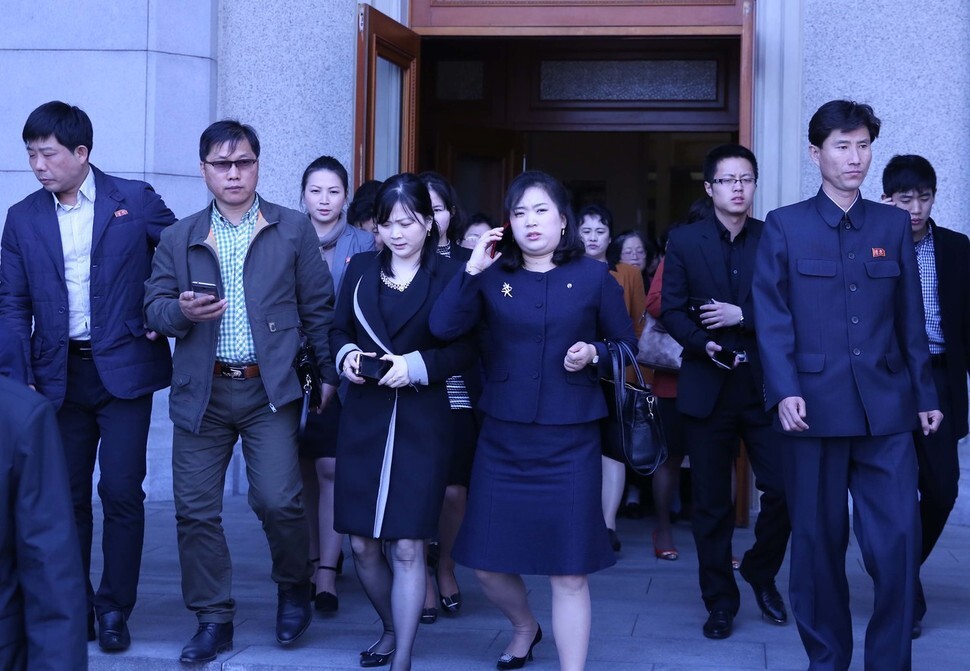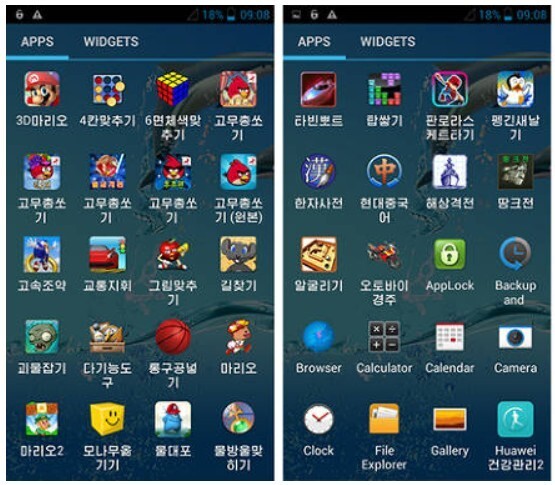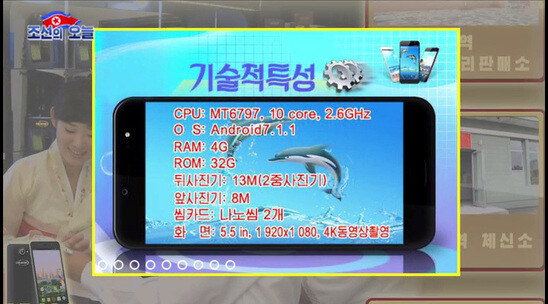hankyoreh
Links to other country sites 다른 나라 사이트 링크
North Korea’s IT proficiency attracts attention worldwide

The daily lives of North Koreans are drawing increasing attention amid growing anticipation of improved inter-Korean relations in the wake of an inter-Korean summit on Apr. 27 and the North Korea-US summit on June 12. US-based journalist Jin Chun-gyu recently published a book titled “Pyongyang Time Flows with Seoul Time” based on his visit to Pyongyang in Oct. 2017, while the North Korean nuclear crisis was intensifying.
The book captures the daily lives of Pyongyang residents in vivid pictures and prose. In terms of walking along the streets with mobile phones in hand, residents of Pyongyang differ little from their counterparts in the South. What are the IT level and usage environment like in the North?
IT in North Korea today
The incident that first truly drew the world’s attention to North Korea’s IT proficiency as an insular state was the Sony Pictures hacking in Nov. 2014. While the identity of the group responsible for the hacking was never uncovered, the fact that North Korea had voiced stern objections to the company’s production and release of the comedy “The Interview” – about the assassination of the North Korean leader – and the FBI’s identification of North Korea as being responsible resulted in the North’s hacking capabilities receiving growing attention.
North Korea’s emphasis on the importance of software dates back to the Kim Jong-il era, and active efforts have been made since to develop computer technology. It has developed and upgraded Red Star, its own open source- and Linux-based operating system, while using its Korea Computer Center (KCC), Pyongyang Information Center (PIC), and Choson Yalu River Technology Development Company as part of an organization to conduct artificial intelligence research and develop various forms of software.
According to the South Korean Ministry of Unification’s North Korea information portal, North Korea instituted mandatory computer education at the fourth-year middle school level and up in 1998 and has graduated around 10,000 IT workers each year through educational institutions including Kim Il-sung University, Kim Chaek University of Technology, Pyongyang University of Science and Technology, and Hamhung Computer Technology University.
Apart from special groups such as diplomatic envoys and researchers granted permission by authorities, ordinary North Koreans cannot access the internet. They can use Kwangmyong – a domestic intranet service opened in 1997 – to access various content administered by the North Korean government. The system is similar to the PC communication services used in South Korea before the internet linked up.

Mobile communications and online environment
Mobile communications and smartphones have been proliferating rapidly in North Korea, and use by the public has been on the rise. Mobile communication services in North Korea began after the 2008 establishment of Koryolink by Egyptian telecom Osracom in conjunction with a local company. Second and third telecoms were established with Kang Song NET in 2012 and Star in 2015; a 3G network is used under the three-company system. International Telecommunication Union figures from 2016 put the number of North Korean mobile phone subscribers at 3.61 million.
“The number of North Korean mobile phone subscribers has recently been estimated at around five million,” said Korea Information Society Development Institute assistant research fellow Kim Bong-sik, who published a report last year titled “North Korean Wired and Wireless Communication Services Today and Their Implications.”
“There’s a lot of commercial activity between individuals in North Korea, and smartphones are seen as essential for doing business,” Kim explained. The numbers suggest around 20 percent of North Korea’s 25 million people use mobile phones or smartphones – the equivalent of roughly one for every one or two households.
While sanctions have been imposed internationally as a result of its nuclear program, North Korea has been producing and distributing its own smartphones and tablets. A variety of smartphone brands are produced and sold in the North, including Arirang, Jindallae, and Pyongyang. Released early this year, the Arirang 171 uses an Android 7.1.1 (Nougat), with 4GB of RAM, 32GB of ROM, and a Deca Core 2.6-GHz processor.
With a 5.5-inch screen and a camera resolution of 13 megapixels, its hardware is not much different from other products on the global market. Since the cost of a smartphone amounts to the equivalent of three months’ pay for an average North Korean worker, the devices also serve as symbols of wealth.

The smartphones are unable to access the internet and do not offer social networking services along the lines of Kakao Talk. Independently developed game, dictionary, and navigation apps are provided, and the devices are mainly used for taking photographs, watching videos, listening to music, and playing games. After a visit to North Korea in January, the Danish developer Christian Budde Christensen shared some of the apps installed on the Arirang’s screen – providing a glimpse into smart phone use in North Korea today.
While social networking services are not available, users communicate activity through text messaging. The North Korean smartphones do not offer access to the internet, but it is not unusual for users around the Chinese border to go online using smartphone accounts established in China.
“You can’t access the internet on a North Korean smartphone, but you can access a lot of different things through the apps, including reports by the Rodong Sinmun and other dailies, various books, and information about farming methods, and they’ve been very helpful in promoting general knowledge for ordinary North Koreans,” said one North Korean defector who now works as a journalist for a North Korea-related news outlet.
Kim Yu-hwang, head of the science, broadcasting, and communications team for the National Assembly Research Service, said, “While the information available through smartphones in North Korea is limited to things that promote the regime, it’s important to note that they have a network in place that could have a substantial impact if opportunities for political and social change should arise.”
By Koo Bon-kwon, senior staff writer
Please direct comments or questions to [english@hani.co.kr]

Editorial・opinion
![[Editorial] Penalties for airing allegations against Korea’s first lady endanger free press [Editorial] Penalties for airing allegations against Korea’s first lady endanger free press](https://flexible.img.hani.co.kr/flexible/normal/500/300/imgdb/original/2024/0502/1817146398095106.jpg) [Editorial] Penalties for airing allegations against Korea’s first lady endanger free press
[Editorial] Penalties for airing allegations against Korea’s first lady endanger free press![[Editorial] Yoon must halt procurement of SM-3 interceptor missiles [Editorial] Yoon must halt procurement of SM-3 interceptor missiles](https://flexible.img.hani.co.kr/flexible/normal/500/300/imgdb/child/2024/0501/17145495551605_1717145495195344.jpg) [Editorial] Yoon must halt procurement of SM-3 interceptor missiles
[Editorial] Yoon must halt procurement of SM-3 interceptor missiles- [Guest essay] Maybe Korea’s rapid population decline is an opportunity, not a crisis
- [Column] Can Yoon steer diplomacy with Russia, China back on track?
- [Column] Season 2 of special prosecutor probe may be coming to Korea soon
- [Column] Park Geun-hye déjà vu in Yoon Suk-yeol
- [Editorial] New weight of N. Korea’s nuclear threats makes dialogue all the more urgent
- [Guest essay] The real reason Korea’s new right wants to dub Rhee a founding father
- [Column] ‘Choson’: Is it time we start referring to N. Korea in its own terms?
- [Editorial] Japan’s rewriting of history with Korea has gone too far
Most viewed articles
- 1Bills for Itaewon crush inquiry, special counsel probe into Marine’s death pass National Assembly
- 2[Editorial] Penalties for airing allegations against Korea’s first lady endanger free press
- 3Months and months of overdue wages are pushing migrant workers in Korea into debt
- 4[Reporter’s notebook] In Min’s world, she’s the artist — and NewJeans is her art
- 51 in 3 S. Korean security experts support nuclear armament, CSIS finds
- 6Trump asks why US would defend Korea, hints at hiking Seoul’s defense cost burden
- 760% of young Koreans see no need to have kids after marriage
- 8S. Korea discusses participation in defense development with AUKUS alliance
- 9Korean firms cut costs, work overtime amid global economic uncertainties
- 10[Guest essay] Maybe Korea’s rapid population decline is an opportunity, not a crisis